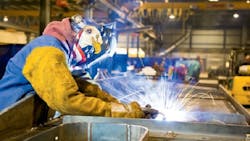More than 975,000 mentions were made in presidential TV advertising about jobs, outsourcing, and trade generally or specifically involving China, as well as Mitt Romney’s involvement with Bain Capital, according to a report released today by Kantar Media’s Campaign Media Analysis Group (CMAG) conducted for the Alliance for American Manufacturing (AAM).
The new report analyzed the broadcast TV advertising airtime devoted to the presidential race as well as key Senate races in four industrial states: Indiana, Ohio, Pennsylvania and Wisconsin. The analysis was based on advertising tracked in all 210 U.S. media markets as well as on 11 national broadcast networks and more than 80 national cable networks.
“Even in today's service-and-dotcom economy, one of the most popular images in 2012 political advertising was the American factory,” said Elizabeth Wilner, vice president of Kantar Media’s Campaign Media Analysis Group. “Whether depicted as desolate through chained gates or shot from a brightly lit, busy floor, the factory starred in an air war dominated by debate over the American economy.”
According to AAM Executive Director Scott Paul, “Both the Democratic and Republican candidates spent a stunning amount of money on television advertising to convince voters that they could best represent the interests of America’s manufacturers and their workers. Obviously they latched on to the right issues because jobs and outsourcing are absolute, top-of-mind issues. Across the partisan spectrum, these issues move voters.”
Wilner’s analysis showed the factory owed its prominence not only to geopolitics but also to “the widespread view among voters of America as a country that makes and builds,” which helped explain why “the factory visual continues to strike a chord.”
In the presidential race, Democrats spent $57 million in TV advertising attacking Gov. Romney’s former firm, Bain Capital, for its alleged practices of shipping jobs overseas or eliminating them altogether. The Obama campaign also devoted substantial advertising to the outsourcing angle, including an ad suggesting that, under Romney’s leadership, Bain laid off workers and destroyed livelihoods.
While the anti-Bain ads received enormous media attention, more money—$68 million—actually was spent to advertise about trade. The two sides spent roughly the same amount on ads mentioning trade, about $34 million, but all the Republican spending went toward ads specifically mentioning China trade. The Romney campaign in particular used ads to accuse the President of not being tough enough on China trade and currency manipulation.
Some key findings of the report:
- Republicans outspent and out-aired Democrats on jobs. In all five races, Republicans spent more money and had higher spot count rates than Democrats on advertising that mentioned “jobs.”
- Democrats’ ads about jobs focused on businesses that sent jobs overseas and laid off workers, which explains why the two sides’ spending and spot-count levels on jobs were closer to parity in the Presidential contest but much further apart in the Senate races. While Bain Capital’s business practices were a major theme of advertising in the race for the White House, the issue was exclusive to that race.
- Despite being outspent and out-aired, Democrats’ messaging on jobs proved more effective. The Democrats used their ads about outsourcing and firing workers to distance the Republican candidates from the voting blocs they needed to win, often punctuating them with taglines such as, “He’s not for us anymore,” and “If [he] wins, the middle class loses.”
- Republican mentions of “jobs” tended to increase, and Democratic mentions tended to decrease, around the release time of the monthly jobs reports.
- “Jobs” was the most-mentioned issue in 2012 advertising by far, not just in the five races but in federal races overall.
China Dominates Trade Debate
In all five of the races examined by CMAG, the majority of trade-centered TV advertising put the spotlight on China. In the Wisconsin and Indiana Senate races, China was the focus of all the TV advertising about trade. In the Pennsylvania Senate race, it was the focus of all Republican advertising about trade. In the Ohio Senate race, the vast majority of trade-related advertising focused on China—and all of it was aired by Democratic advertisers.
“China has become a pivotal issue,” said Paul. “The only question now, after all the hundreds of millions that have been spent, is whether the winning candidates will follow through on their promises. Voters will be watching for action.”
About the Author
IW Staff
Find contact information for the IndustryWeek staff: Contact IndustryWeek
